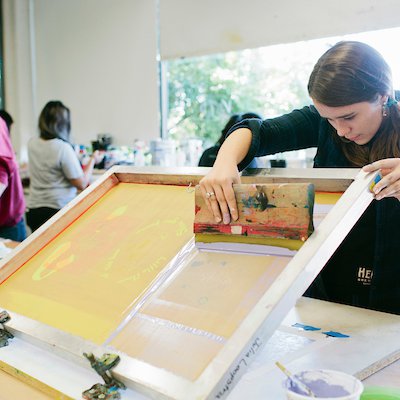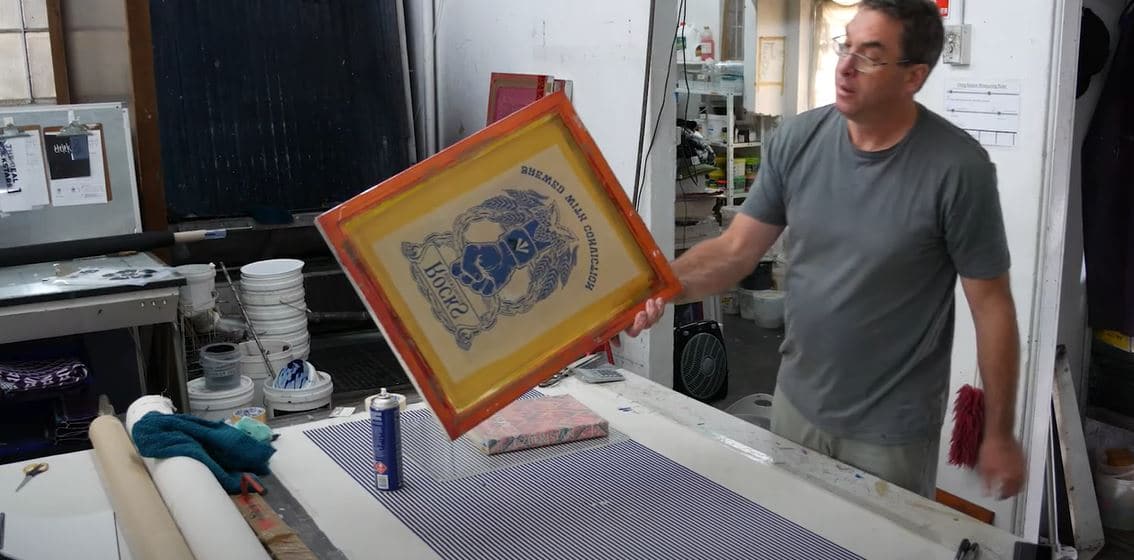The Necessary Overview to Recognizing Screen Printing and Its Versatile Uses
Screen printing has a rich background that dates back to old times, evolving right into an innovative method made use of throughout numerous markets today. This guide checks out the intricacies of the screen printing procedure, detailing its applications in fashion, marketing, and home design - 10:9 Design near me. Recognizing these basics can open creative capacity for both industrial and artistic tasks. The adhering to sections will expose necessary ideas and techniques to enhance one's screen printing undertakings
The Background of Screen Printing
Although screen printing has roots that map back centuries, its development reflects the creative and technological improvements of numerous societies. Coming from old China, the technique was initially utilized for decorating fabrics and later spread to Japan, where it became essential to Ukiyo-e woodblock printing. The approach shifted to Europe in the 18th century, where it gained appeal among artisans and commercial printers. The creation of photo solution in the 20th century transformed screen printing, permitting for more complex styles and higher performance. Musicians like Andy Warhol additionally propelled its appeal, utilizing the tool to develop iconic jobs that combined commercialism and fine art. By the late 20th century, screen printing had actually developed itself as a flexible strategy, employed in vogue, marketing, and art. Today, it proceeds to progress, integrating electronic modern technology and broadening its applications across various industries.
The Screen Printing Process Explained
Screen printing transforms creative visions right into substantial layouts through a collection of specific actions. Originally, an image is produced and after that transferred onto a screen, normally made from great mesh material extended over a structure. A light-sensitive emulsion is put on the screen, which is subjected to light, solidifying in areas not covered by the picture. After washing out the unhardened emulsion, a pattern is developed.
Next, the screen is placed over the substratum, whether it be material, paper, or another product. Ink is after that pushed through the open areas of the pattern using a squeegee, depositing the design onto the substrate below. This procedure can be repeated for multiple shades, calling for separate screens for every hue. The published item is healed using heat to ensure the ink adheres correctly, resulting in a resilient, lively layout ready for usage.
Sorts Of Screen Printing Techniques

In addition, specialized methods, such as discharge screen printing, remove dye from the textile to create softer prints, while foil screen printing uses metallic aluminum foil to achieve a shiny finish (10:9 Design Screen Printing Texas). Each strategy offers unique characteristics, accommodating various imaginative demands and production ranges, eventually increasing the opportunities within the screen printing domain name
Applications of Screen Printing in Different Industries

Additionally, the signs and marketing sectors use screen printing for producing eye-catching displays and banners. This approach permits vibrant colors and elaborate styles that record interest. In electronics, screen printing is utilized for applying conductive inks to motherboard, vital for part links. The home décor industry embraces screen printing to produce distinctive designs on textiles and wall surface art. On the whole, screen printing acts as a crucial device throughout varied areas, improving items with personalized and visually appealing graphics.
Tips for Effective Screen Printing Projects
While embarking on a screen printing job, cautious interest to detail can considerably enhance check my blog the last outcome. Choosing top notch materials is crucial; this consists of the screen, inks, and substratums. Utilizing suitable mesh counts can impact ink deposition and detail resolution. Prep work is similarly essential; extensive cleaning of screens and correct exposure times assure crisp prints.
Next, exact enrollment is vital for multi-color prints. Using alignment devices can assist attain precise layering. In addition, testing prints on scrap products prior to production assists identify potential concerns without losing resources.

Regularly Asked Inquiries
What Products Are Finest for Screen Printing on Material?
Cotton and polyester blends are excellent for screen printing on textile as a result of their durability and ink absorption. In addition, specialized textiles like silk or canvas can produce special textures and coatings, improving the total layout high quality.
Exactly how Do I Clean and Maintain Screen Printing Equipment?
To cleanse and keep screen printing equipment, one need to regularly clean displays with appropriate solvents, evaluate mops for wear, lubricate relocating components, and store all items in a completely dry, dust-free atmosphere to lengthen their life expectancy.
What Are the Ecological Impacts of Screen Printing?
Screen printing can have considerable ecological influences, including chemical waste from inks and solvents, water use during cleaning procedures, and energy intake. Lasting techniques and green materials are vital for reducing these adverse impacts.
Can Screen Printing Be Done in the house Successfully?
Screen printing can be effectively done at home with the appropriate materials and door sign printable strategies. Hobbyists can produce quality prints, though success depends upon their ability level, tools, and understanding of the process entailed.
What Are the Costs Connected With Starting a Screen Printing Organization?

Starting a screen printing organization involves prices for devices, products, and workspace. Initial expenditures usually vary from a few hundred to numerous thousand dollars, depending upon the range, high quality of equipment, and wanted manufacturing ability.
Screen printing has an abundant background that dates back to ancient times, progressing right into an advanced strategy made use of throughout numerous sectors today. One more strategy, rotating screen printing, uses round displays, promoting continuous printing on material rolls, consequently enhancing efficiency for large-scale productions. In addition, specialized methods, such as discharge screen printing, eliminate dye from the material to create softer prints, while aluminum foil screen printing uses metal aluminum foil to attain a glossy finish. In the fashion sector, screen printing is extensively made use of to develop lively styles on clothing, allowing brands to showcase their distinct styles. Cotton and polyester blends are ideal for screen printing on textile due to their durability and ink absorption.